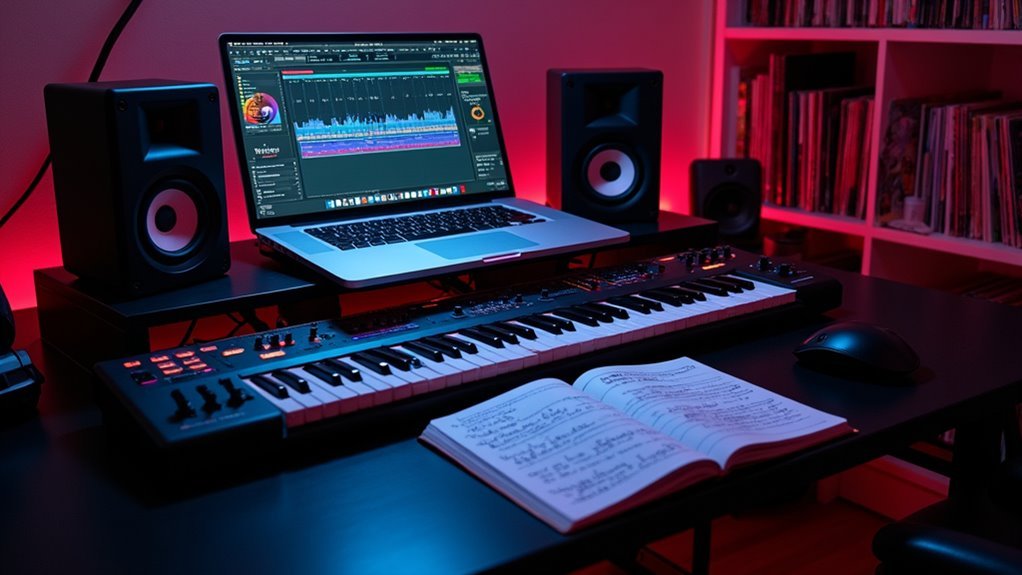Let’s cut through the noise about trap chord progressions. We’ve analyzed hundreds of trap hits to distill exactly what makes them click. Those dark, haunting melodies aren’t random – they’re built on specific progressions that trigger an emotional response. From the classic F#mAD to the gritty BmG sequence, these patterns form the backbone of modern trap. What’s fascinating is how just a few simple chord changes can create such a powerful sonic impact. Ready to reveal these secrets?
The 8 Most Popular Trap Chord Progressions

While trap music’s signature sound comes from its thundering 808s and rapid hi-hats, it’s the chord progressions that give tracks their emotional punch.
Let’s explore five proven trap chords that dominate the genre.
Dive into the backbone of modern trap music through these essential chord progressions that define the genre’s signature sound.
F#mAD delivers a dramatic shift from dark to light, perfected in “Lean On.”
The FmDbC combination of chords packs serious energy, as heard in “Hard In Da Paint.”
Don’t sleep on BmG – this minor chord to major progression anchors “No Hands” with its moody-to-uplifting change.
“Bad and Boujee” proves AC#mBF#’s power to create rich atmospheric depth.
And for those seeking the unexpected, EmBmAmEb throws a curveball with its Eb resolution, giving “Lemonade” its distinctive edge.
These progressions aren’t just theory – they’re battle-tested formulas that deliver instant trap credibility.
Root Notes and Keys That Define Trap Music
Three foundational root notes define trap music’s signature sound – and you’ll need to master them.
We’re diving into the dark, moody world of trap’s minor scale foundation, where E minor, B minor, and F minor reign supreme. These keys create the emotional depth that makes trap so compelling.
- Root notes establish the tonal center for your chord progressions
- E minor delivers that classic, haunting trap atmosphere
- B minor offers versatility for both melodic and aggressive tracks
- F minor creates an intense, brooding foundation
- Switching between these minor keys adds dynamic contrast
Master these root notes and you’ll gain the ability to craft authentic trap progressions that hit hard.
Remember: your root note choice sets the entire emotional trajectory of your track. Get this right, and everything else falls into place.
Mastering the Art of Trap Chord Writing

Now that you’ve got your root notes locked in, let’s build the chord progressions that’ll make your tracks unforgettable. Minor Chords dominate the trap landscape, creating that essential dark vibe that hooks listeners instantly.
| Progression | Emotional Impact | Usage Example |
|---|---|---|
| F#m-A-D | Melancholic | Drake-style tracks |
| Bm-G | Mysterious | Future-style beats |
| Em-C-G | Introspective | Travis Scott vibes |
Start with basic scale patterns, then level up by experimenting with inversions and parallel modes. We’re seeing massive results when producers mix traditional Minor Chord sequences with borrowed chords. Remember: Trap Chord Progressions aren’t just about theory – they’re about feeling. Keep your progressions simple but potent, using repetition strategically while maintaining rhythmic variation to avoid monotony.
Creative Techniques With Chromatic and Diminished Chords
Let’s plunge into the dark magic of chromatic and diminished chords, where trap production gets seriously twisted.
Moving beyond the Major Scale’s predictable patterns, we’re diving into territory that’ll make your beats absolutely menacing.
- Shift notes chromatically (by half-steps) to build gut-wrenching tension
- Stack diminished chords strategically for that signature trap darkness
- Layer chromatic basslines under stable chord progressions for maximum impact
- Mix diminished and chromatic elements to create unsettling atmospheric shifts
- Use these techniques sparingly – they’re potent tools that pack serious punch
These advanced chord techniques aren’t just theory – they’re essential weapons in modern trap production.
DJ Snake and Waka Flocka Flame have proven how effective these elements can be.
Master them, and you’ll reveal new dimensions of trap’s signature sound.
Advanced Tips for Crafting Dynamic Trap Progressions

Taking your trap progressions from basic to boss-level requires mastering advanced techniques that’ll set your tracks apart.
Let’s explore inversions first – they’re game-changers when moving between two chords, creating buttery-smooth shifts that’ll elevate your sound instantly.
Don’t limit yourself to standard progressions. Mix major chords with minor ones from parallel modes to inject emotional complexity. This helps create those signature trap moments that hit different.
Layer your progressions with multiple synths and pads, but keep it tactical – each layer should serve a purpose.
Watch how pros use syncopation to keep listeners guessing. Throw in a non-diatonic chord when you need that dramatic punch, but use it sparingly.
Frequently Asked Questions
What Is the Progression for Trap?
We’ll find common trap music techniques use minor-key progressions like F#mAD (iIIIVI) and FmDbC (iVIV). These chord progression examples create dark atmospheres perfect for trap melody strategies.
Is It Illegal to Steal Chord Progressions?
Like Shakespeare’s plots borrowed from history, chord progressions aren’t protected by copyright. We’re free to use them, but we should consider musical influence ethics while maintaining chord originality in our arrangements.
What Key Is Best for Trap Music?
We’ll typically find trap music works best in minor keys, especially E minor, B minor, and F minor. These popular trap keys create the dark, moody characteristics that define the genre’s sound.
What Is the Most Catchy Chord Progression?
We absolutely love the BmG (iIV) progression for insanely catchy melodies. It’s proven its emotional impact through countless popular examples, and we’ve found it’s simple enough for listeners to instantly connect with.